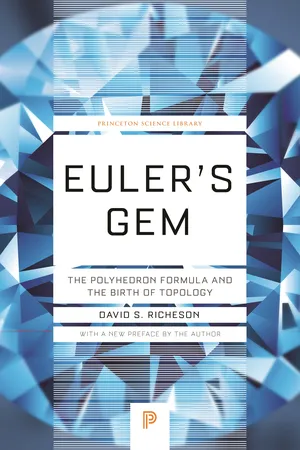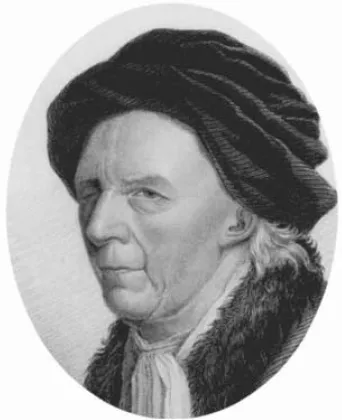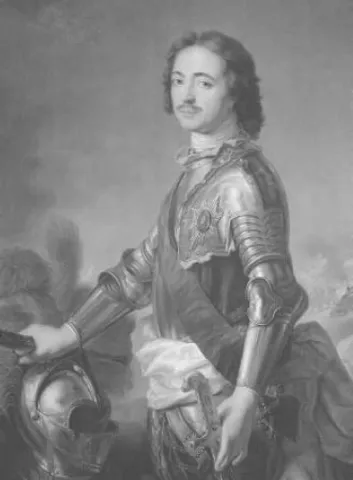![]()
CHAPTER 1
LEONHARD EULER AND HIS THREE “GREAT” FRIENDS
Read Euler, read Euler, he the master of us all.
—Pierre-Simon Laplace1
We have become accustomed to hyperbole. Television commercials, billboards, sportscasters, and popular musicians regularly throw around sensational words such as greatest, best, brightest, fastest, and shiniest. Such words have lost their literal meaning—they are employed in the normal process of selling a product or entertaining a viewer. So, when we say that Leonhard Euler was one of the most influential and prolific mathematicians the world has ever seen, the reader’s eyes may glaze over. We are not overselling the truth. Euler is widely considered, along with Archimedes (287–211 BCE), Isaac Newton (1643–1727), and Carl Friedrich Gauss (1777–1855), to be one of the top ten—or top five—most important and significant mathematicians in history.
In his life of seventy-six years, Euler created enough mathematics to fill seventy-four substantial volumes, the most total pages of any mathematician. By the time all of his work had been published (and new material continued to appear for seventy-nine years after his death) it amounted to a staggering 866 items, including articles and books on the most cutting-edge topics, elementary textbooks, books for the nonscientist, and technical manuals. These figures do not account for the projected fifteen volumes of correspondence and notebooks that are still being compiled.
Euler’s importance is due not to his voluminous output but to the deep and groundbreaking contributions he made to mathematics. Euler did not specialize in one particular area. He was one of the great generalists: he had expertise that spanned the disciplines. He published influential articles and books in analysis, number theory, complex analysis, calculus, calculus of variations, differential equations, probability, and topology. This list does not include his contributions to such applied subjects as optics, electricity and magnetism, mechanics, hydrodynamics, and astronomy. Furthermore, Euler possessed a trait that was and is rare among the top scholars: he was a first-rate expositor. Unlike the mathematicians who preceded him, Euler wrote using clear, simple language that made his work accessible to experts and students alike.
Figure 1.1. Leonhard Euler.
Euler was a gentle, unpretentious man whose life was centered around his large family and his work. He lived in Switzerland, Russia, Prussia, and then again Russia, and corresponded extensively with many important thinkers of the eighteenth century. His professional life was linked to three “Great” rulers of Europe—Peter the Great, Frederick the Great, and Catherine the Great. The legacies of these leaders include the creation or revitalization of their countries’ national academies of science. These academies supported Euler so that he could spend time on pure research. The only repayment they expected was the occasional use of his scientific expertise for matters of the state and the recognition that his celebrity brought to the nation.
Leonhard Euler was born in Basel, Switzerland, on April 15, 1707, to Paul Euler and Marguerite Brucker Euler. Shortly afterward, the family moved to the nearby town of Riehen, where Paul took a job as the minister of the local Calvinist church.
Leonhard’s earliest mathematical training was provided by his father. Although Paul was not a mathematician, he had studied mathematics under the famed Jacob Bernoulli (1654–1705). This instruction took place while Paul and Jacob’s younger brother Johann (1667–1748), both students at University of Basel, boarded at Jacob’s home. Jacob and Johann Bernoulli were members of what was to become the most esteemed family in mathematics. For over a century the Bernoulli clan played an important role in the advancement of mathematics, with at least eight Bernoullis making lasting contributions.
Leonhard began his formal studies at the University of Basel at the age of fourteen. This was not an unusually young age for a university student at that time. The university was quite small—it had only a few hundred students and nineteen professors. Paul hoped that his son would follow a career path into the ministry, so Leonhard studied theology and Hebrew. But his mathematical abilities were undeniable, and he quickly attracted the attention of his father’s friend Johann Bernoulli. By this time Johann was one of the leading mathematicians in Europe.
Johann was an arrogant, brusque man with a competitive streak that produced storied rivalries (with, among others, his brother and one son). Yet he recognized the boy’s remarkable talents and encouraged him to pursue mathematics. Euler wrote in his autobiography, “If I came across some obstacle or difficulty, I was given permission to visit him freely every Saturday afternoon and he kindly explained to me everything I could not understand.”2 These lessons played a valuable role in the maturation of Euler’s mathematical skills.
Even as Leonhard excelled in his private mathematical studies, Paul held out hope that his son would enter the ministry. At the age of seventeen, Euler earned his master’s degree in philosophy. Johann feared that mathematics might lose his protégé to the Church, so he intervened and told Paul in no uncertain terms that Leonhard had the potential to become a great mathematician. Because of his fondness for mathematics, Paul relented. Even though Euler abandoned the ministry, he remained a devout Calvinist for his entire life.
Euler’s first independent mathematical accomplishment came at the age of nineteen. His theoretical work on the ideal placement of masts on a ship secured him an accessit, or “honorable mention,” in a prestigious competition sponsored by the French Académie des Sciences. This feat would be incredible for any teenager, but was especially so for a Swiss youth who had never seen a ship on the ocean. Euler did not win the top prize for this competition, which would have been roughly equivalent to winning a Nobel Prize today, but in the years to come he won the highest honor on twelve occasions.
Figure 1.2. Peter the Great of Russia.
At the time of Euler’s birth, a thousand miles to the northeast of Basel, the Russian tsar Peter the Great (1672–1725) was building the city of St. Petersburg. It was founded in 1703 on the marshy swampland where the Neva River flows into the Baltic Sea. Peter used forced labor to construct both the city and the strategically located Peter and Paul Fortress on an island in the Neva. He loved this new city, calling it his “paradise” and naming it after his patron saint. Despite the fact that most Russians, especially government officials, did not share Peter’s feelings about this cold, wet place, he moved the Russian capital from Moscow to St. Petersburg. The young Euler had no way of knowing that this city would be his home for much of his life.
Peter the Great, a physically imposing figure who stood nearly seven feet tall, was the energetic, self-taught, determined leader of Russia from 1682 to 1725. Known as a ruthless reformer, he began the transformation of his country from an agrarian and feudal nation dominated by the Church into a powerful empire. His goal of modernizing—that is to say, Westernizing—Russian government, culture, education, military, and society was largely realized. As one Russian historian wrote, “All of a sudden, skipping entire epochs of scholasticism, Renaissance, and Reformation, Russia moved from a parochial, ecclesiastical, quasi-medieval civilization to the Age of Reason.”3
As part of the process of Westernization, Peter wanted to reform Russia’s educational system, which was nonexistent before his reign except for minimal teaching by the powerful Orthodox Church. As a result, Russia had no scientists. Because of the strong presence of the Church, Russians were fearful of scientific explanations of the world, preferring instead the traditional religious explanations. Peter recognized the need to improve Russia’s international image and to dispel the notion that Russians hated science. He also knew that having a science program was crucial for creating and maintaining a powerful state.
Peter visited the Royal Society of London and the Académie des Sciences in Paris, both of which were founded in 1660. He was impressed with what he saw. He also admired the new Berlin Academy of Sciences, which was founded in 1700 upon the advice of Gottfried Leibniz (1646–1716). Leibniz is the famed mathematician who, along with Isaac Newton, is credited with the invention of calculus. These academies were not universities; they were “dedicated to the search for new knowledge and not the dissemination of existing wisdom.”4 The members of the academies were scholars, not teachers; their prime objective was the advancement of knowledge.
Peter wanted to create an academy such as the ones in Paris, London, and Berlin, and he wanted to establish it in his new city of St. Petersburg. For advice he turned to Leibniz. For nearly two decades, Peter and Leibniz had extensive conversations, both through letters and in face-to-face meetings, about education reform and the creation of an academy of science.
In 1724 Peter finalized his plans for the creation of the Academy of Sciences in St. Petersburg; it was the final and most ambitious project in his quest to improve Russia’s educational system. However, he could not model his academy exactly on the European academies. Because Russia had no native scientists, he would have to persuade talented foreign scientists to relocate to St. Petersburg. Also, because Russia had no university system, the Academy of Sciences must function as a university. Part of the mandate of the Academy was to train Russians in science so that the Academy would not always have to rely on the foreigners.
Peter never saw the fruits of his labor; he died in early 1725. Thanks to the new empress, Peter’s second wife, Catherine I (1684–1727), plans for the Academy continued. Foreign scholars began arriving within months of Peter’s death, and the Academy of Sciences held its first meeting before the end of the year. Peter was fortunate that Catherine embraced the idea of the Academy. In the years that followed, the Academy was not always blessed with such sympathetic leaders. During the thirty-seven years between Peter’s death and the coronation of Catherine the Great (1729–1796), Russia was led by six rulers, and the Academy was always at the mercy of these opinionated and powerful people.
Initially the Academy was staffed by sixteen scientists: thirteen German, two Swiss, one French—and no Russians. The large German presence and the absence of Russians would later be a source of tension.
Because of the cold climate, the remote location, and the academic isolation, it was necessary to offer high salaries and provide comfortable accommodations to lure these scientists to St. Petersburg. The new academy was small, but it quickly fulfilled its promise of being an important, internationally renowned scientific institution. Eventually it became the center of all scientific scholarship in Russia. The Academy of Science has had several name changes, but it is still exists today and is known as the Russian Academy of Sciences.
Two of the foreign scholars who were stars of this new institution were Euler’s friends, and Johann Bernoulli’s sons, Nicolaus (1695–1726) and Daniel (1700–1782) Bernoulli. The two brothers had spoken to Euler about the Academy before they left Switzerland, and they promised to secure him a position as soon as possible. Immediately upon their arrival in Russia, they began lobbying the administrators of the Academy to hire their bright young friend. Their campaigning paid off quickly. In 1726 Euler was offered a position in the medical and physiology division. Unfortunately, Euler could not fully enjoy nor celebrate this exciting job offer. He was hired to fill an opening created by the tragic and untimely death of Nicolaus.
Euler was grateful for the job, but he did not move to Russia immediately. He had two reasons for remaining in Basel and putting his new job on hold. First, he had accepted a job in medicine, but he possessed only minimal knowledge in that area. So he decided to remain at the University of Basel and study anatomy and physiology. Second, he was stalling for time as he waited to hear if he would be offered a faculty position in physics at the University of Basel. In the spring of 1727, when he heard that he was not chosen for the job, he left for Russia. So began his life in St. Petersburg, where he lived for the next fourteen years and then again for the last seventeen years of his life.
Euler’s journey to St. Petersburg by boat, foot, and wagon took seven weeks. On the day that he set foot in Russia, Empress Catherine I died after ruling for only two years. The fate of the new Academy was uncertain. Those who ran the country on behalf of the eleven-year-old tsar Peter II (1715–1730), the grandson of Peter the Great, saw the Academy as an expendable luxury and contemplated closing its doors. Fortunately, the school remained open, and in the confusion that ensued, Euler ended up where he rightly belonged—in the mathematical-physical division, not in the medical division. This first year of Euler’s mathematical career, 1727, was also the year the mathematical giant Isaac Newton died.
Life at the Academy was difficult under Peter II, so the members of the Academy hoped that their fortunes would improve following the death of the fifteen-year-old tsar in 1730. The Academy did fare slightly better during the ten-year reign of Anna Ivanovna (1693–1740), but conditions in Russia turned bleak. Anna brought into her government a strong German influence, most notably her lover Earnst-Johann Biron (1690–1772). Biron was a ruthless tyrant who executed several thousand Russians and exiled tens of thousands more to Siberia. Those targeted by Biron included common criminals, Old Believers (of the Russian Orthodox Church), and Anna’s political opponents. Later, when in Berlin, Euler was asked by the Queen Mother of Prussia why he was so taciturn. He replied, “Madam, it is because I have just come from a country where every person who speaks is hanged.”5
In 1733, having had enough of the difficult Russian lifestyle and the internal politics at the Academy, Daniel Bernoulli moved back to Switzerland, and, at the age of twenty-six, Euler stepped into Daniel’s role as head mathematician.
At this point, Euler realized that he might be in Russia for a long time, perhaps for the rest of his life. With the exception of hardships imposed by the political climate in Russia, Euler found a comfortable life. He acquired a good command of the Russian language, and he felt financially secure thanks to the higher salary that came with his promotion. So, in 1733 he decided to marry Katharina Gsell, the daughter of the Swiss-born painter Georg Gsell who had been brought to Russia by Peter the Great. Leonhard and Katharina started a family, eventually producing thirteen children. As was not uncommon in that day, only five of them lived past childhood, and just three outlived their parents.
Being a husband and a father did not slow down Euler’s stream of publica...


